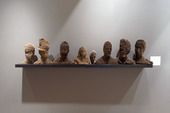Highlight
Next Action: Art, Technology & Apprenticeship
Achievement/Results
The concept of project based learning is not new, but is gaining significant momentum recently as a way of helping students learn key academic content and important 21st century skills such as computational thinking, collaboration, creativity and innovation, and information literacy. Central to Project Based Learning is a process of inquiry in response to a challenge or complex problem. With our group of high school students, and in collaboration with the Scottsdale Museum of Contemporary Art, the project was to create a high-profile exhibition of digital and interactive art. Our driving question with the students was always: how can we create digital artwork that engages with the audience? In order to create this work the students had to learn a wide range of digital tools and skills including image and video editing software, digital cameras and video cameras, 3D design software, 3D scanning software and hardware, laser cutters, 3D printers, large format printers, electronics and sensors, and programming environments.
Skills and domain knowledge are not separable but intertwined and must be taught together. Often however with younger students knowledge is shallow, which makes related skills difficult to engage with. One area where students’ knowledge and motivation is strong is on creative projects that are aesthetically beautiful and engaging. Young people are increasingly exposed to a wealth of advanced creative output made possible by recent advances in digital and electronic tools including video narratives, interactive multimedia, games, infographics and visualizations, music, and sound. These projects resonate with kids because they have a certain cultural authenticity and engage with a vast community. What might not be obvious is the wide range of skills that must be employed to create these popular digital cultural products.
The high school students began to formulate their own visions of what they wanted to create for the exhibition. With help from IGERT graduate students, each high school student was able to learn enough new skill to refine and complete at least one piece of art for the SMoCA exhibition. We finished the artwork and installed it at SMoCA. The exhibition “Next Action, Art + Technology” opened and was a big success. Examples from the exhibition include:
- Image Average portraits consisting of combined photos from a school yearbook
- Laser cut 3D heads constructed from 3D models captured using multi-angle photographs
- High resolution visualizations analyzing the image content in popular movies
- Gigapixel images constructed from hundreds of stitched images
- Audio and video compilations created algorithmically using software that shuffles together many pieces of content
- Projection mapped videos created to be projected directly onto 3D shapes
- Analysis of human motion captured using the Microsoft Kinect videogame interface
In each of these cases the motivation was to create something visually fascinating to display in a high-profile exhibition. In order to accomplish this the kids had to learn new techniques, tools, and skills. They had to collaborate, communicate, and refine their ideas and output. In most cases they had to also grasp various required basic science, technology and math concepts as well. For instance, in order to create a large scale visualization of a movie, one student had to learn to analyze the color information on each frame by condensing a matrix of image information into a single color value, then write an algorithm that would iterate this procedure through hundreds of thousands of frames of video in the film, and store this analysis data in a text file for yet further analysis and representation. In other words, they had to invent a mathematical filtering mechanism to condense a huge set of movie data into a single image.
Address Goals
This project points to a way of fostering and advancing STEM learning by using project based learning in a way that engages young people. By using digital and electronic art as the driving question, students became naturally interested in the math, science, and engineering needed to accomplish their aesthetic goals. They solved problems and learned new skills not for the sake of gathering the skills themselves, but because they were deeply involved in a creative exploit they felt was authentic, and they had a desire and pressure to share this creative work with their families, friends, and the larger art community as a whole.
In order to create the work the students wanted to create, they simply had to learn new math, science, engineering and technical skills as well as problem solving techniques, collaboration and communication strategies. These are at the core of 21st century skills. Although we were working on digital art, the same skills will continue to serve these students even in very different contexts. In addition, by posing an artistic question to the students, we were able to engage a wide variety of types of students, including students who ordinarily would shy away from the technical STEM related topics. These students, who typically would prefer to work on creative projects, are often quite able and willing to tackle difficult STEM problems, but only need a different motivation to do so. This type of STEM learning engagement is broadly inclusive and can accommodate a wide variety of skill levels and personality types. While working on these projects, the students gained a deeper understanding of the STEM concepts and skills and they developed workplace skills and important learning habits. The art project central to this project allowed the students to interact with a wide variety of mentors, use the latest technology, and present their work to their community. The feedback the students received from not only their family and friends, but complete strangers who were truly touched and amazed by the artwork (and in some cases willing to buy it), gave the students a tremendous sense of pride and excitement.
This type of creative project based learning has the potential to engage students with STEM concepts and 21st century skills who might otherwise find the concepts intimidating, or meaningless.







